I tried 8 plant-based, high-protein pastas, and my favorite contained cauliflower and parsnips
Su-Jit Lin

- I tried 8 plant-based, protein-packed pasta brands to see which one is the best.
- I found that chickpea pastas were the creamiest, and red-lentil varieties were the earthiest.
- My favorite of the bunch was a green-lentil pasta that was mixed with cauliflower and parsnip.
To keep things fair, I tested eight brands of spiral pasta with the same red sauce.
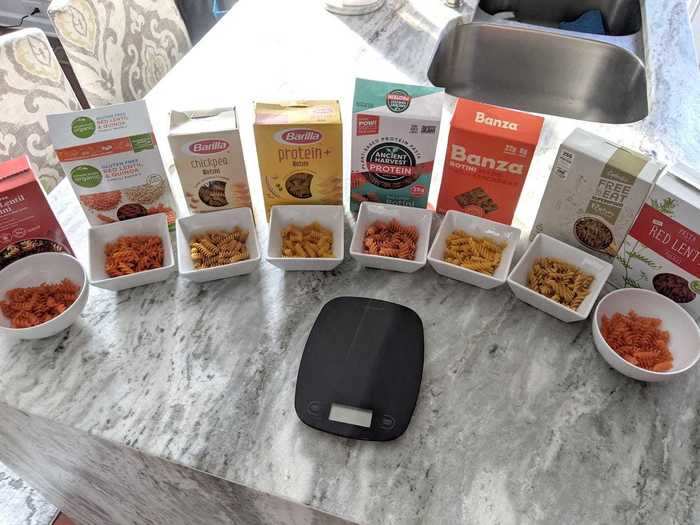
I bought as many protein-packed pasta brands as I could find to put them to the test.
They've recently become available in a wider range of shapes, but since penne has a tendency to break and spaghetti can get soggy and sticky if not handled properly, I decided to only use spiral noodles for the taste test.
To prepare the pasta, I individually cooked 1 1/2 ounces of each brand in a small pot of water for around seven minutes.
I first tasted them all plain while still warm, then again after they cooled to see if the texture changed. For the second part of the test, I reheated the pasta and tossed it in Rao's Homemade tomato-and-basil sauce.
Read on to see how it went.
It seemed appropriate to start with one of the original protein-pasta brands, Banza.
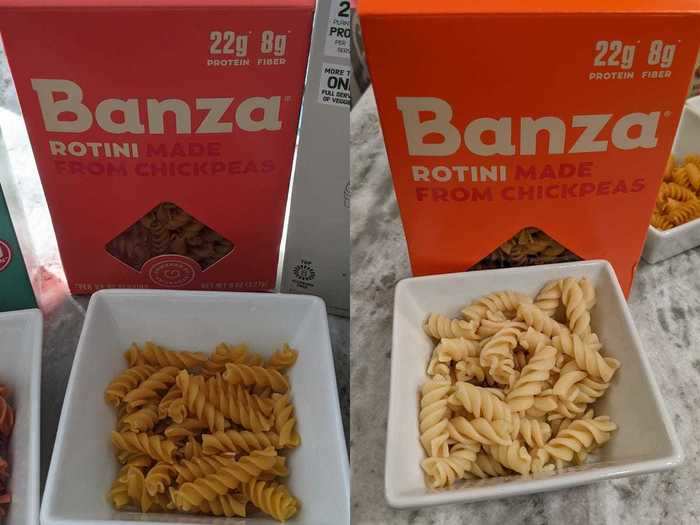
Protein per serving: 13 grams
Banza's classic rotini is made from chickpeas, tapioca, and xanthan gum. Other varieties within the brand also add pea protein to the mix.
Opening the box revealed looser spirals with a semi-glossy sheen cut at irregular lengths.
The noodles were definitely starchier than some regular pastas, so I had to rinse them after they boiled. They kind of looked sad and unappealingly soggy even though that wasn't the texture at all.
I followed the al-dente instructions and ended up with a springy, chewy, and slightly gummy rotini.
The flavor started off a little sweet, with a hint of smoothly pureed chickpea. Then the creaminess developed over time.
The noodles also got softer as I ate them and tackier as they cooled.
The Banza pasta was among the most neutral of the bunch, and it held the sauce very well, which gave it a nice flavor.
Next up was the only non-gluten-free entrant, Barilla Protein+ rotini.
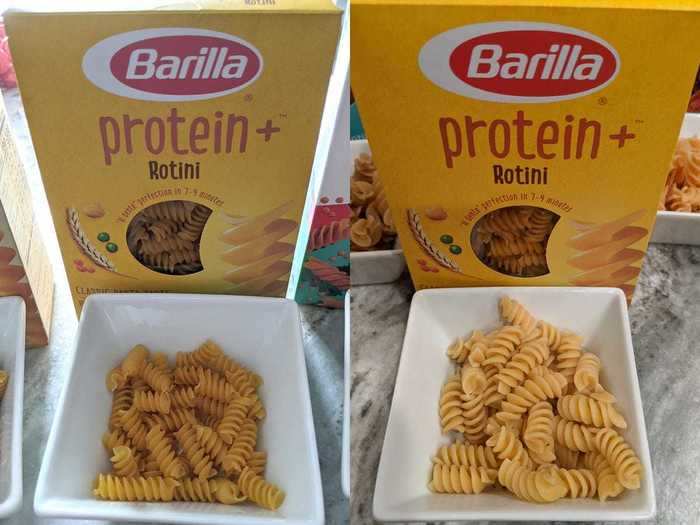
Protein per serving: 10 grams
Unlike the other contenders, Barilla's Protein+ pasta contains gluten in the form of semolina, durum wheat, barley, and spelt flour.
These ingredients purportedly give it a "classic pasta taste," even though it's supplemented with lentils, peas, and chickpeas.
The noodles were cut at irregular intervals, with tight, thick spirals.
The pasta emerged underdone at the seven-minute mark, so I cooked it for one more minute until it was al dente.
The tight coils maintained their shape while doubling in volume, giving the pasta a great texture.
The first bite seemed promising, with a real-pasta flavor, but then it took a turn. After that neutral start, the pea started subtly peeking through and building to an unmistakable flavor for those who've had pea-protein-powder shakes.
Luckily, the flavor got less harsh as the pasta cooled, and with enough sauce, it was mostly undetectable.
After the detour into wheat-based pasta, I tried out Barilla's chickpea rotini.
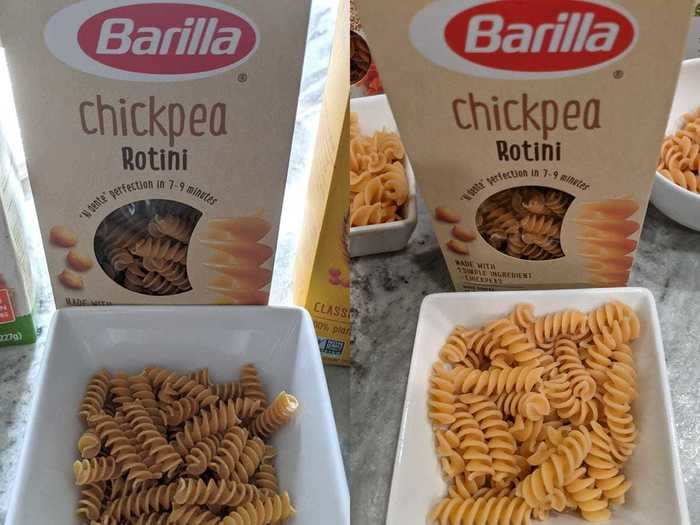
Protein per serving: 11 grams
I appreciate that the only ingredient in this Barilla pasta is chickpeas. There was also a slight curve to the noodles, which likely indicates that they were tender when they were fresh-cut from the line.
As they cooked, the tight, medium-length coils swelled up in the pot.
They were sweet at first bite, ending with a creaminess that could lend itself to a variety of sauces. Unexpectedly, the chickpea flavor actually got more pronounced with tomato sauce, but not in an unpleasant way.
The texture was on the dry side and there was a grittiness to the noodles, but it wasn't too powdery, even when cold.
Once it cooled, I only needed to fluff it a little to make the noodles spring back to life.
Next was Ancient Harvest's red-lentil rotini.
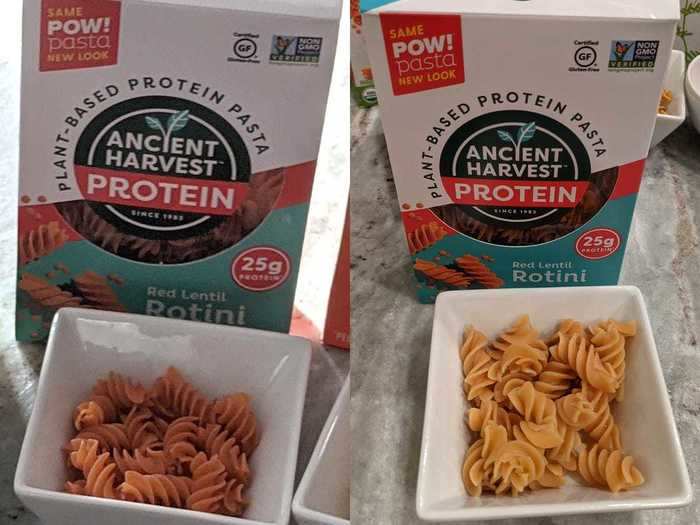
Protein per serving: 14 grams
Ancient Harvest's protein-packed pasta is made from a combination of quinoa and red-lentil flour.
The extra-thick-cut rotini was the fattest, densest, and tightest spiral I tried. They were almost more like radiatori noodles.
Although these took a little longer in the pot because they were so dense, I made sure to watch them diligently because red lentils can overcook quickly and become mushy.
The noodles filled the water with starchy residue while they cooked, so rinsing was not only advised but also necessary to dilute the wafting beany smell.
The aroma definitely strengthened the lentil taste of the pasta. It had a very earthy flavor with a bitter edge that came through with every bite and got more pronounced as it cooled.
The pasta also started unexpectedly falling apart as it softened over time, so it definitely wouldn't do well in a cold dish, like pasta salad.
The key was to eat it with a lot of sauce to drown out the bold lentil flavor. Luckily, the tomato sauce got wonderfully trapped within the swirls and brought out a creaminess in the pasta
I then moved on to Simple Truth Organic's red-lentil-and-quinoa fusilli.
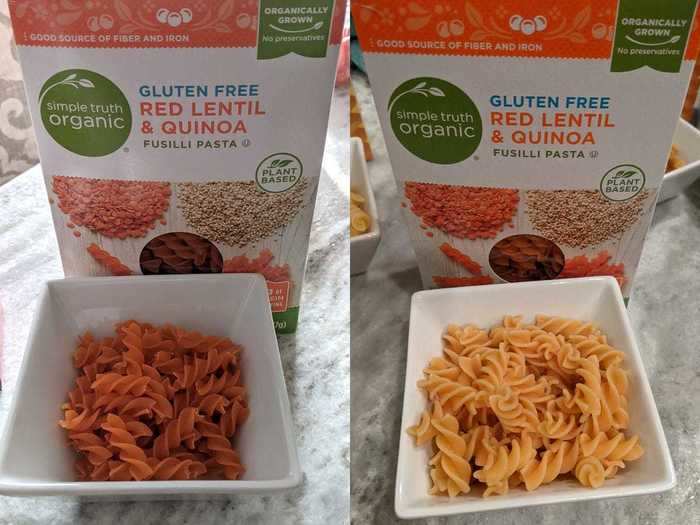
Protein per serving: 13 grams
Simple Truth Organic's loose, unevenly cut noodles aren't to be confused with traditional fusilli, which is spun around a thin rod to create a coil similar to an old-school phone cord. These are machine-made and short, like rotini.
This thinner noodle started out the most translucent, which wrongly led me to assume they'd be lighter-tasting, too.
The noodles swelled up dramatically in the pot. The water didn't look starchy after cooking, but the pasta itself became very stiff and powdery.
Rinsing the noodles in cold water didn't do much to tone down the aggressive lentil flavor, which was more pronounced in some bites than others. There was also a sour element to the pasta that became more evident after cooling and reheating.
The sauce helped a little, but this pasta was my least favorite because it broke down and got gritty really quickly.
Pasta Lensi was the next red-lentil variety in the lineup.
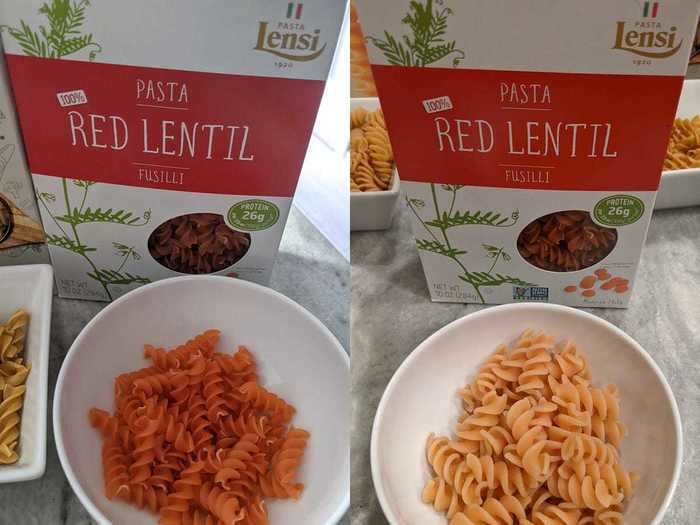
Protein per serving: 15 grams
I had high hopes for this Italian-imported lentil pasta.
These noodles were definitely some of the starchiest of the bunch, and even rinsing them after draining didn't seem to help much.
Taste-wise, it wasn't overly lentil-y at first, and even when the flavor popped up, it wasn't pervasive. When cooled, it dissipated into a hint of what can only be described as a sweet finish.
The tomato sauce clung well to the short fusilli, and the pasta's smooth texture had a lovely chewiness to it.
The noodles stuck together a little, but it was nothing a quick oil-toss couldn't fix, making this an excellent choice for light dishes.
Target's Good & Gather red-lentil rotini was suspiciously identical to Pasta Lensi's.
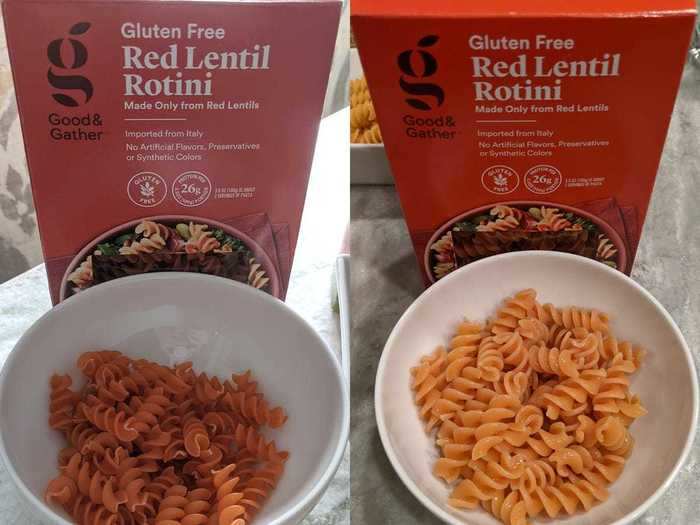
Protein per serving: 15 grams
When I poured this pasta out of the box, I couldn't help but notice that it looked and felt almost identical to the Pasta Lensi variety I just tasted.
The red-lentil noodles were also imported from Italy, and the macros were similar across both brands. In fact, the only thing that differentiated the two was the slightly shorter cut of the Target-brand pasta.
Like its twin, the noodles also left the water looking starchy, but they cooked to a chewy, firm texture.
They had a creamy, smooth flavor with a present but not unpleasant beaniness and a mildly sweet aftertaste.
There was a trace of powderiness to the texture that wasn't apparent in the Lensi variety, but otherwise, it was a total budget dupe.
Last but not least, I tried Cybele's green-lentil pasta with bonus veggies.
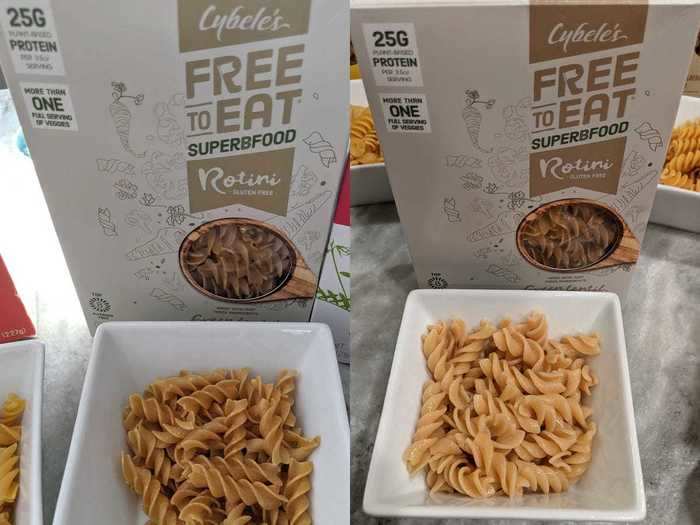
Protein per serving: 15 grams
Cybele's Free to Eat rotini was the only green-lentil pasta I found after an exhaustive search at local stores.
The brand mixes the star legume with veggies, and I went with the cauliflower and parsnip combination because it seemed like the most neutral, and therefore, the fairest to test.
When raw, the pasta felt denser and had grainy spots where you could see particles of the different vegetables. But it actually cooked up into smooth, sweet, and subtle noodles.
After cooking, the drained pasta looked mushy and limp, but the box warned that it would seem soft. I just had to rinse it in warm water and let it cool a bit for it to firm up.
Thanks to the parsnip and cauliflower, the earthy, lentil flavor was mild from the first bite to the last.
On the whole, it was neutral and delicious, and the texture was ideal for al-dente fans like me. It had a fantastic "real" pasta texture with a longer chew.
It was also awesome with sauce, even though it didn't capture as much of it in its folds as other cuts.
These pastas were all pretty good for upping your protein intake, but Cybele's was the best.
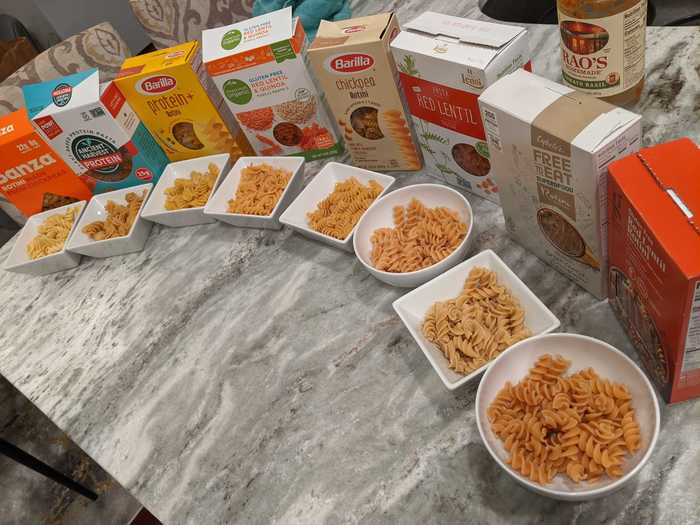
Cybele's pasta was a sleeper hit, and I'm excited to try the other interesting flavor combinations the brand makes, like green lentil, kale, broccoli, and spinach.
The green-lentil, cauliflower, and parsnip combination blended well with the sauce and left a mildly sweet aftertaste.
If creamy pasta is more your jam though, the sturdy Barilla chickpea pasta was excellent, surpassing Banza in flavor (but not in texture).
On the red-lentil side, Good & Gather is a cheaper but equally high-quality dupe for Pasta Lensi, and Ancient Harvest is really only for those who're looking for a bold, earthy flavor.
READ MORE ARTICLES ON
Popular Right Now
Popular Keywords
Advertisement